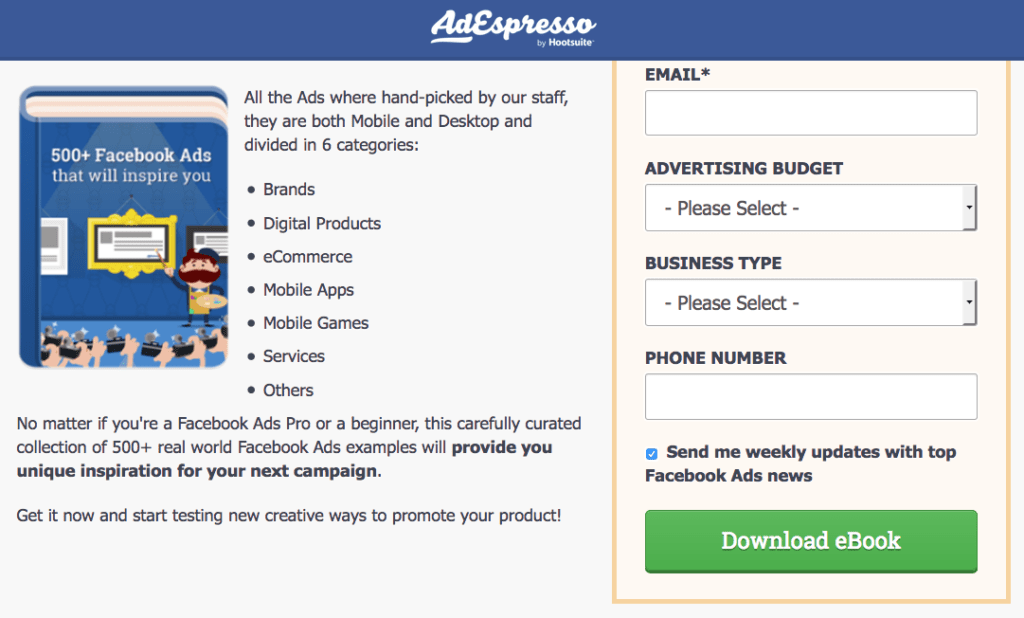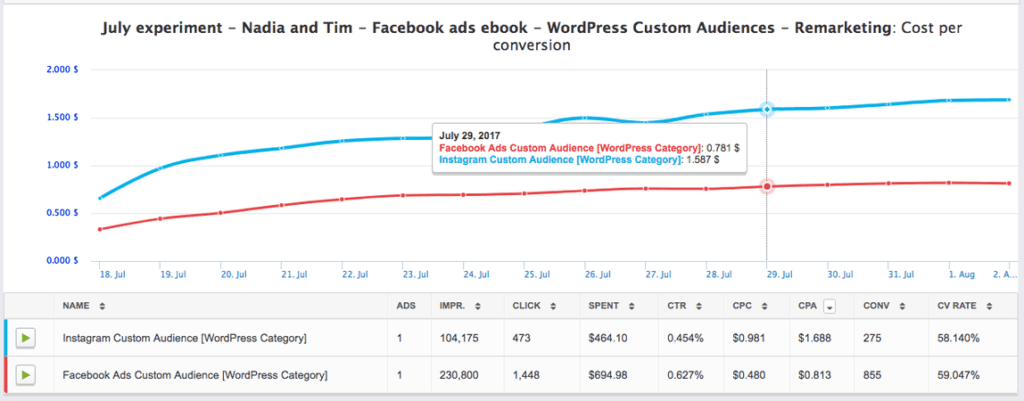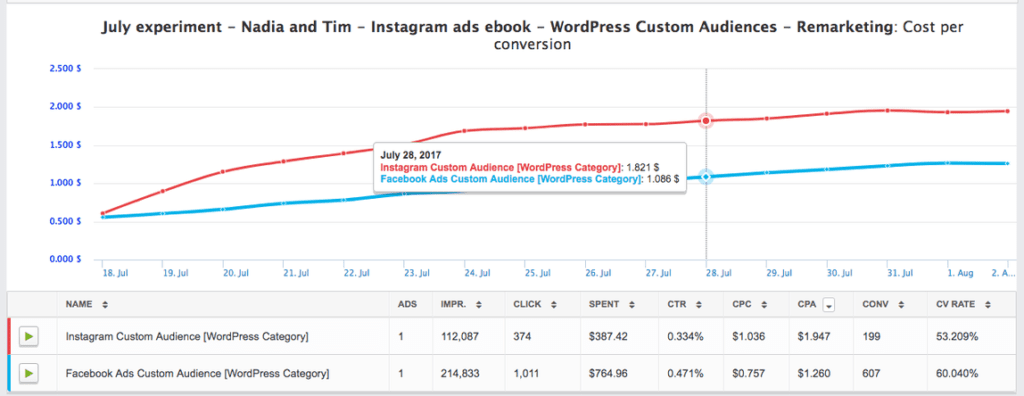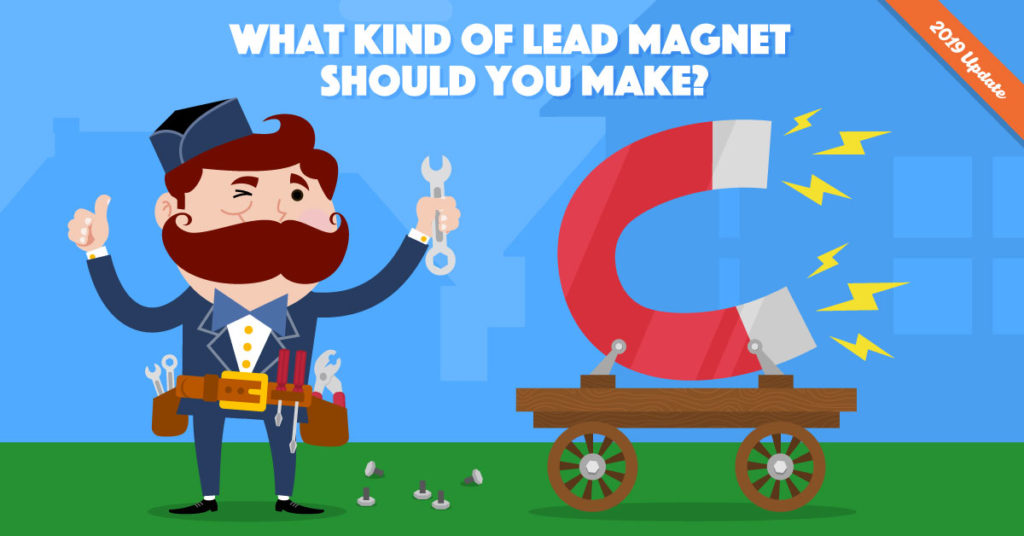Lead magnets are the incentives you offer a potential customer in exchange for their contact information.
Done right, they’re one of the best tools for collecting names and email addresses from your audience. But a good lead magnet works only when it’s valuable to your audience.
So when you promote it, you’re going not for views, likes, or shares, but you go straight for new leads.
Great lead magnets can turn your social media advertising into a powerful acquisition channel.
And that’s exactly what we’re gonna show you in this post: how to use lead magnets to get real leads from your social media ads!
And to show you exactly how it works, we run an experiment for you!
First of all, remember this:
Creating a valuable lead magnet and proving that value to a customer, are two very different things.
In this article, we’ll cover how to decide which types of lead magnets to promote and give you a few tips for how to think about which audiences to target.
And, as an added bonus, we ran an experiment with our own Facebook and Instagram profiles to show you how it works!
Deciding What Type of Lead Magnet to Promote
Your lead magnet needs to align with your target customers’ specific needs and interests.
That not only makes it easier to provide value but also helps you create ads that are targeted to specific subsets of your audience who are more likely to appreciate that value.
That’s why effectively promoting your lead magnets is more difficult than promoting other ad campaigns.
It’s harder to achieve your conversion goals when you’re asking for more than just a click or a share. Your target audience is much further down the sales funnel and needs more convincing to enter their contact information.

Lead magnets should target customers in the Interest and Decision stage of the sales funnel. Via Hootsuite.
Consider a popular lead magnet for B2B SaaS companies: the free tool.
This is typically a simple tool that helps bring in new customers by helping them accomplish a certain task. You wouldn’t offer this kind of tool to someone who’s not aware of your brand, but if they’ve actively expressed an interest in your company or are looking to make a purchase, this lead magnet can help seal the deal.
Your lead magnet could also be:
- a checklist that helps someone perform a website audit;
- an ebook or infographic about sales funnel optimization; or
- a discount code for their next purchase.
Each of these lead magnets provides a different type of value for potential customers. So how do you know which type of lead magnet to promote?
First, determine who you want to click through the ad.
Create buyer personas for your different customers, and figure out what’s valuable to them. Understanding how to provide the right kind of value will make your lead magnet more enticing.
“You can get far by making your marketing valuable and inviting,” says the founder and CEO of Wistia, Chris Savage.
Your lead magnet should also be entertaining.
When your industry is competitive, be delightful or surprising to stand out.
Take this ad from design company Canva. Not only does it speak to the value of their product, but it does so in a way that’s engaging and delightful. They’re also offering Pro features for free, which is the real value add for potential customers.
While the ad is definitely eye-catching, the free trial is the way Canva gets someone to actually click through.
These tactics work together to show the value of your product.
Whether you’re sharing expert information, helping customers accomplish a task, or simply brightening their day, the lead magnets you promote should always work toward building stronger relationships with the customer.
Why You Need to Target the Right Audience with Lead-Magnet Ads
It is difficult to inspire potential customers into action when your lead magnet tries to appeal to more than one target audience. That’s why the audience you target needs to be specific.
When you target an audience that’s too broad, your ad will end up in front of customers who aren’t as interested, which can lead to more hidden ads and a decrease in overall performance.
Facebook provides you with tools to see how broad or defined your audience is, based on the details you select:
|
Example of a broad audience for a Facebook ad |
 Example of a specific audience for a Facebook ad |
Ensuring that your lead magnet is in front of the right kinds of people makes the most of your advertising spending as well.
Let’s say you’re selling a monthly subscription meal box meant for busy tech professionals. Recipients enter their height, weight, and typical activity information before their first order. Then, the recipes are nutritionally optimized to provide just the right amount of calories, the right macronutrient breakdown, and the right supplemental vitamins.
While you might be tempted to go broad with your Facebook advertisement reach and target all people in the 18-to-34 age bracket, or all people working in the technology sector, it’s much more effective to find the specific people who have signaled interest in similar topics.
Use Facebook Ads Interest Targeting to build this audience.
For example, target people who work in tech companies who have also expressed an interest in cooking, recipes, health, and wellness.
To show just how important specific targeting is for lead-magnet ads, we designed an experiment to test our assumptions in the real world.
Finding the Perfect Audience: An AdEspresso Experiment with Custom Categories
One of the most difficult parts of any advertising strategy is building the perfect audience. Depending on the ad’s design, the campaign type, the time of year, and so on, audience engagement can vary drastically. This is especially true of lead magnets, which are tailor-made to appeal to specific subsets of that audience.
We wanted to find out just how much of an impact this had on lead magnets and lead-magnet ads, so we asked ourselves the following questions:
Our first thought was “Yes, absolutely!” But we wanted to run the test to see exactly how much.
Here was our hypothesis: The Facebook Ads ebook will have a cheaper cost per conversion when advertising to the Facebook Ads blog readers category but will have a higher cost per conversion when advertising to Instagram Ads readers of our blog category (and vice versa).
In other words, the content of the ebook will have a direct impact on the cost per conversion based on which audience you’re displaying it to.
What we needed for the experiment:
- Two WordPress Category-based Custom Audiences: one for the Facebook Ads Category on our blog and one for the Instagram Ads Category on our blog
- Two lead magnets: 500+ Facebook Ad Examples and 137 Instagram Ad Examples
How we structured the campaign
We started by creating two Clicks to Website campaigns:
Campaign 1: 500+ Facebook Ad Examples Targeting Facebook and Instagram Blog Readers


Here’s how they looked on Facebook:
 Campaign #1 – 500+ Facebook Ad Examples. Live Facebook ad example. |
 Campaign #2 – 137 Instagram Ad Examples. Live Facebook ad example. |
And here’s how they looked on Instagram:


We also created dedicated landing pages for each ad, both of which were forms where users entered their email addresses in exchange for our free Ads Examples ebook.
One promoted 500+ Facebook Ads ebook:


How we decided on where to place the ads
For this experiment, we enabled all the placements except for Audience Network to avoid the risk of junk clicks from outside of Facebook’s platform.
We then set a budget of $75 per day for a two-week campaign, meaning we invested $1,050 per campaign. We based this decision on audience size because our Custom Audiences had different retention rates, and we wanted to make sure that each got a fair share of the budget.
From there we had to decide on a bidding strategy. We decided on automatic bidding and optimized both campaigns for off-site conversions. We also paid for Impressions.
Outcomes
The outcome of our 500+ Facebook Ads Example Campaign met our expectations. The Facebook Custom Audiences we created brought a lower cost per conversion (CPC), more clicks, and impressions. The number of conversions was almost four times higher for the WordPress Category Audience of Facebook Ads than in the Instagram audience.
There was also a much lower cost per action (CPA).

But we were surprised by the results of the 137 Instagram Ad Example campaign:

Here, the Instagram Custom Audience actually resulted in a higher CPA than the Facebook custom audience did ($1.974 vs. $1.260).
In other words, the ebook on Facebook Advertising provided cheaper leads than the ebook on Instagram Advertising, even though we were advertising to Instagram Ad blog readers.
Takeaways
The number one takeaway from this experience is that it’s always worth matching the specific audience to the specific product.
But it’s also worth testing.
We wanted to know why the Facebook Custom Audience performed better from a CPC perspective for both audiences. We have two conclusions:
- The topic of the ebook likely made a difference. According to our research, Facebook Marketing ebooks consistently outperform ebooks about Instagram.
- A larger audience brings in more conversions at a lower CPA. It also reduces the frequency rate, or the number of times a specific user is served the same ad.
So, what does that mean for you?
- Matching your lead magnet to a specific audience is the best way to boost the success of your ads across multiple dimensions.
- The more people in your custom audience, the more opportunities there are for success.
- Testing different audiences ultimately leads to cheaper ads because you can refine your strategy based on the findings.
Lead Magnets Are Just the Beginning
Integrating a lead magnet into your advertising strategy helps you acquire leads cheaply and efficiently.
But that’s just the first step in a long process of nurturing and converting these leads into customers.
Here are some more articles to read as you get started with your lead-generation campaign:
- Lead Generation with Facebook Ads — The Definitive Guide
- How to Create Facebook Lead Ads and Sync Them With Your CRM
- The 5 Emails You Need to Nurture Your Leads
- The Comprehensive Guide to Building an eBook For Your Lead Magnet
- How to Create an Irresistible Lead Magnet
What do you think? Do you use lead magnets in your advertising strategy? Is there anything else you’d want us to test? Leave a comment and let us know!



Car advertising is something worth trying these days! It promises a profit time from car magnets! The article is really informative!
Thanks for sharing this informative post with us.
amazing article about lead magnets. it is so important to make our magnets more specific to our target audience and add value. Just simply throwing an ad and expecting people to submit their details will never work.